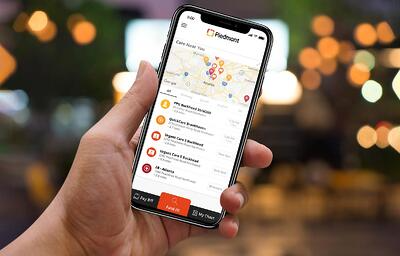
As the consumerization of healthcare grows, more patients expect healthcare systems to offer convenient, personalized experiences. Having a system-branded mobile engagement platform is a first step in that direction—but it’s important to ensure the mobile platform delivers distinctive, ongoing opportunities. Extensible mobile wayfinding has the capability to drive adoption and return engagement of the app, offer measurable patient experience improvements, and build new avenues for business development.
Piedmont Healthcare, a $3.8 billon, eleven-hospital system in Georgia launched its mobile wayfinding platform in July 2017. PiedmontNow, the system’s mobile engagement platform, provides users with interactive maps and step-by-step navigation to doctor’s offices, on-site dining, pharmacies, restrooms, parking decks and other points of interest.
This mobile engagement platform does more than fulfill its fundamental mission of helping patients find their way around facilities with hospital wayfinding by offering advanced features that give patients the ability to access urgent care and emergency department wait times, virtual visits, appointment scheduling, physician directories, electronic health records, ride share services, bill pay, and more. Providing this continuity of care via a patient’s smartphone is a key driver for revenue at Piedmont.
This case study details two years of Piedmont Healthcare’s success with implementation and continuous improvement of their mobile platform that provides a one-stop, robust user experience and metrics to measure the system’s patient experience efforts.
Piedmont Healthcare’s rapid growth through acquisition and new construction over the past several years has broadened their reach throughout the Atlanta market and across Georgia. While this growth has allowed them to better serve their patients, it inherently adds layers of complexities in navigating the physical landscape, as well as the patient journey.
Piedmont chose a mobile platform with wayfinding recognizing that today’s patients are almost never without their mobile devices and expect immediate access to a health system’s locations and services with the tap of a button.
During the development phase of the PiedmontNow App, leadership listened to both patients and employees in various settings to understand areas of opportunity that a digital transformation to the patient journey could provide. Piedmont concluded that a mobile wayfinding solution would:
Eliminate the hassle of navigating the system and locations
Improve access to the health system services
Provide a tool that enables employees to better deliver Piedmont’s vision of service by helping patients more effectively
Engage staff and assist in maintaining Piedmont’s commitment to care throughout acquisitions and growth
With a keen understanding of drivers of consumerism in healthcare: access, choice and experience, PiedmontNow delivers a continuity of care experience that is easily navigable when on any campus, is personalized, and has a retail look and feel.
“Providing stress-free, safe guidance to the hospital is a top priority for improving patient experience at Piedmont. We chose to capitalize on the growing reliance on smartphones for retrieving online information and directions. By employing Gozio’s powerful, innovative technology, our patients and families feel confident in arriving at their destination anywhere in the Piedmont system,” notes Matt Gove, chief consumer officer at Piedmont.
“The demonstrated success of our mobile platform helps to realize Piedmont’s mission of quality, safety and service,” says Katie Logan, vice president experience, Piedmont Healthcare. “PiedmontNow offers patients transformational, next generation access to medical services and a unified hassle free experience.”
When measuring the platform’s value to consumers, one metric Piedmont executives watch closely is session frequency. With an average of 4-8 times per user, the session frequency metrics of PiedmontNow shows it has a significant sticky factor with users. Platform analytics validate that once patients install the app for wayfinding they return to reengage with additional features.
Out of the gate Piedmont’s mobile engagement platform proves to be a service that differentiates the system from competitors and is truly helpful in delivering on consumer needs. Robust session frequency analytics mirror the organization’s objective to create an experience-based red thread that ties the system together across points of care and enhances Piedmont’s value proposition in a sustainable manner.
The immediate success and goal-breaking adoption of PiedmontNow encouraged the system to roll out another strategic business development initiative through its mobile platform.
The redesigned home screen prompts patients to schedule an appointment at the provider of their choice or nearest Urgent Care or QuickCare location. It also allows patients to Save Spot at an Urgent Care or QuickCare location or get immediate directions to the closest emergency department.
Online scheduling has grown significantly with the home screen redesign of the PiedmontNow app. PiedmontNow analytics reveal an impressive conversion rate from click to fulfillment of appointment at thirty percent (30%). Online scheduling also reflects a significant increase in new patients to the Piedmont system. Twenty-six percent (26%) of all online scheduled patients are new to Piedmont including QuickCare, which jumps to 39% of new patients through mobile and online scheduling.
The impressive rates of online scheduling via PiedmontNow fulfills an organizational key objective to improve conversion rates between points of care within the Piedmont Healthcare system.
Since its launch in July 2017, Piedmont actively monitors the platform’s analytics and listens to feedback from staff to make continuous improvements to PiedmontNow’s user experience.
“When looking at analytics to determine improvements, it is critical to stay focused on your why and the strategic imperative for mobile engagement,” says Logan.
Some initial lessons learned to increase installations of the app include:
“During planning, think about success and how to ensure continuous feedback and growth along the way. Then look at your platform metrics knowing what you are solving for up front. When you know how you are going to track those key objectives, monitor platform analytics and stay flexible to improvements. The momentum between feedback and improvements maintains the sticky factor of the app. Patients will engage to do other things like appointment scheduling,” says Logan.
As Piedmont pilots deep integration of electronic health records (EHR) with their mobile wayfinding platform, what’s on the horizon for the organization is providing patients with an even greater personalized mobile experience. Piedmont’s vision of deep integration of EHR is to optimize patient workflow and create a seamless experience as patients interact between their EHR and PiedmontNow.
Patients will receive appointment reminders, then go directly to step-by step directions from their home to the right parking garage and on to their point of care. After their appointment, they will be guided to return to their car with a parking spot locator and can efficiently schedule follow up appointments, message their caregiver, access lab results or prescription information. This continuity of care will be completely accessible from the PiedmontNow mobile platform.
The current, dynamic healthcare landscape requires hospitals to engage with patients as both patients and consumers often to meet the demands and expectations that occur outside of a hospital’s four walls. Consumers are looking for a convenient, personal and memorable experience with their healthcare providers, and smartphones represent prime real estate for a hospital system to deliver an immediate connection. With an anytime, anywhere connection between hospitals and patients, a strong mobile strategy can take patient engagement to a whole new level, positively affecting patient experience, patient education and addressing clinical improvements.
Piedmont’s extensible mobile wayfinding platform has proven to be a valuable channel for the health system to engage with patients—before, during and after each encounter—in a way patients welcome.
The original version of this page was published at: https://www.goziohealth.com/blog/piedmont-healthcares-proven-success-with-mobile-wayfinding
Gozio Health offers an end-to-end, customizable digital health platform exclusively for healthcare systems. Gozio’s extensible mobile platform enables seamless consumer interactions and provides an... Read more
This week we continue our look at some of the latest insights on patient experience coming from new surveys and recent events. We discussed the highlights of NGPX and the ...read more
After attending many conferences and other events and talking to a lot of Gozio customers, we’ve gotten a pretty good idea of what the priorities and focus will be in 2023. In ...read more
...read more
In our third and final conversation with ChatGPT, we asked it what the future held. Again, nothing surprising or super in-depth. I think we can safely say that ChatGPT can spit out ...read more